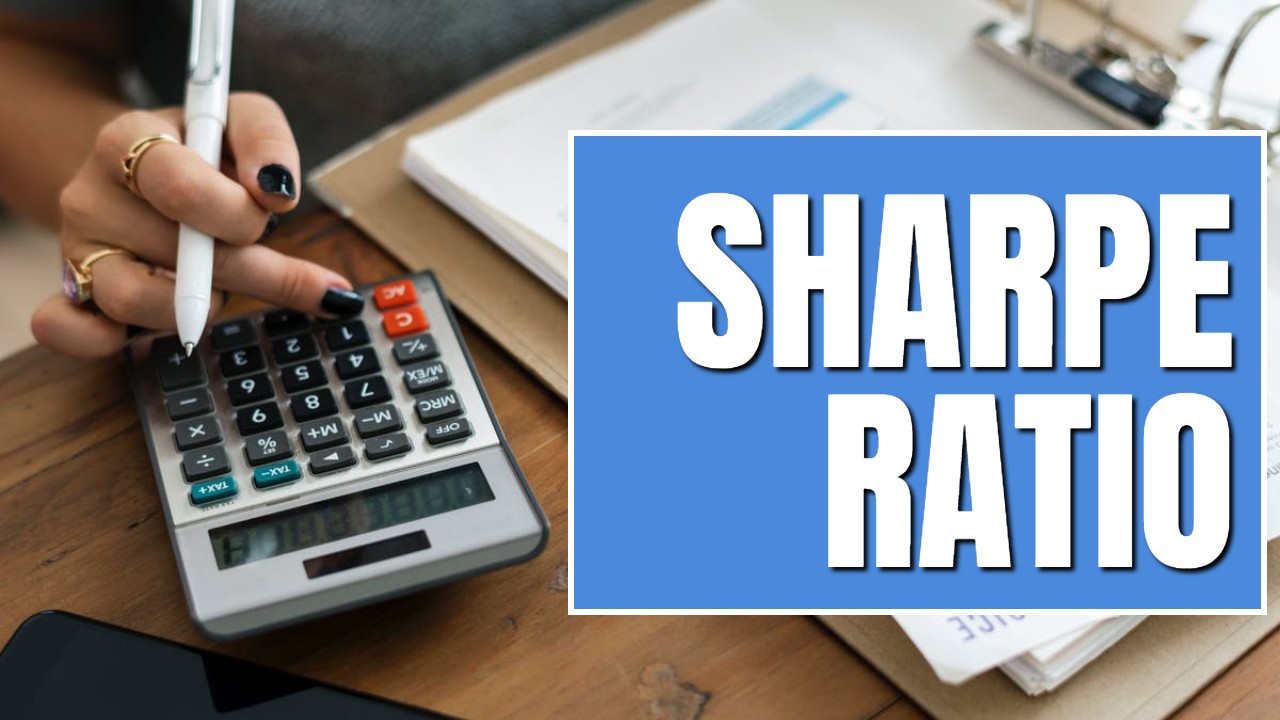Understanding and Applying the Sharpe Ratio for Risk-Adjusted Returns
Investing always involves a delicate balance between risk and return. So, understanding how these two forces interact is crucial for any successful investor. This is where the concept of risk-adjusted returns comes in. To master that, you must understand an important metric, the Sharpe Ratio.
This article is a deep dive into the Sharpe Ratio. Besides helping you understand the concept, it’ll teach you how to use it in your stock investment decisions. So, without further ado, let’s start by defining the term.
What is the Sharpe Ratio?
The Sharpe Ratio is like your investment report card. It helps answer the question, “Am I getting enough reward for the risk I’m taking?”. Developed by Nobel Prize-winning economist William Sharpe, this simple tool evaluates investments by considering their risk-adjusted returns.
Imagine you’re an investor considering two different stock portfolios. Both have delivered similar returns over the past year, but one has experienced much higher volatility (or risk) than the other. This metric can help you determine which has provided a better return Vs risk, allowing you to make a more informed decision.
How Do You Calculate the Sharpe Ratio?
You calculate The Sharpe Ratio using the following formula:
Sharpe Ratio = (Portfolio Return – Risk-Free Rate) / Standard Deviation of Portfolio Returns
Here’s a breakdown of the components of this formula:
- Expected Return: This is the gain (or loss) you expect from your investment, usually expressed as an annual percentage.
- Risk-Free Rate: Refers to the return you could earn on an investment with virtually no risk, such as a U.S. Treasury bill.
- Standard Deviation: Is a measure of how much your investment’s price fluctuates around its average.
Let’s put it all together with a simple example. Imagine you have an investment portfolio that earns an average return of 10% per year, and the risk-free rate is 2%. The standard deviation of your portfolio’s returns is 15%.
Plugging these numbers into the formula, you’d calculate your Sharpe Ratio as follows:
Sharpe Ratio = (10% – 2%) / (15%)
= {0.08}{0.15}
= 0.53
Interpreting the Sharpe Ratio
Now that you know how to calculate the Sharpe Ratio, it’s important to understand what different values mean. So, here’s how to interpret it:
- Positive Sharpe Ratio: Indicates that your investment has generated returns exceeding the risk-free rate. In other words, you’re getting a decent bang for your back.
- Negative Sharpe Ratio: Suggests that the investment has performed below the risk-free rate on a risk-adjusted basis. It could indicate a poorly performing investment or one with excessive risk relative to its returns.
So, what’s a good Sharpe Ratio? Generally speaking, the higher, the better. But what exactly constitutes a “good” ratio can vary depending on your investment goals and risk tolerance. As a rule of thumb, many consider a Sharpe Ratio above 1 acceptable and anything above 2 excellent.
Comparing Investments with the Sharpe Ratio
After understanding how to calculate and interpret the Sharpe Ratio, let’s discuss how to use it to compare different investments. Again, imagine you’re torn between two mutual funds — fund A and fund B. Both offer promising returns but with varying risk levels. How do you decide which one is the better choice?
Let’s say Fund A has an average annual return of 10%, with a standard deviation of 12%. Meanwhile, Fund B has delivered an average annual return of 8%, with a standard deviation of 6%. At first glance, Fund A seems more attractive due to its higher returns. Wouldn’t you say so?
However, when you calculate the Sharpe Ratios (assuming a risk-free rate of 3%), you get the following:
Fund A Sharpe Ratio = (10% – 3%) / 12% = 0.58
Fund B Sharpe Ratio = (8% – 3%) / 6% = 0.83
It’s clear from the calculations that Fund B has a higher Sharpe Ratio. That indicates that it has provided better risk-adjusted performance than Fund A. For the level of risk taken, Fund B has delivered higher returns relative to the risk-free rate.

Assumptions and Limitations
We have shown that the Sharpe Ratio is a powerful tool for evaluating risk-adjusted returns. However, it has its assumptions and limitations, which are important to understand. Here is a snippet of some of the main ones:
1. Normal Distribution of Returns:
The measure assumes that investment returns typically follow a bell-curve pattern. However, in reality, returns may not always follow a normal distribution. That’s especially true during periods of market turbulence or extreme events.
2. Standard Deviation as a Risk Measure:
Secondly, it uses standard deviation to measure risk, which captures the overall volatility of returns. However, standard deviation treats positive and negative deviations equally. Thus, it may not accurately reflect the true risk perception of investors, who are generally more concerned with downside risk.
3. Sensitivity to the Risk-Free Rate:
Choosing the risk-free rate can significantly affect the ratio calculation. Different investors or analysts may use different risk-free rates. That makes it challenging to compare Sharpe ratios across different analyses or sources.
4. Time Sensitivity:
Moreover, the Ratio can be sensitive to the time chosen for the analysis. Different periods may yield different Sharpe Ratio values for the same investment. This makes it important to consider a consistent and appropriate timeframe when comparing investments.
Despite these limitations, the ratio remains a widely used and valuable tool for assessing risk-adjusted returns. However, it’s essential to consider it alongside other risk-adjusted measures, such as the Sortino Ratio or the Calmar Ratio, and qualitative factors, such as investment objectives, risk tolerance, and investment horizon.
Applications of the Sharpe Ratio
The Sharpe Ratio has a wide range of applications in the investment world, including:
1. Portfolio Optimization and Asset Allocation:
You can use it to optimize your portfolio construction by selecting investments or asset classes with the highest risk-adjusted returns. This helps you achieve better diversification and maximize portfolio returns.
2. Evaluating and Comparing Investment Managers or Funds:
Many investors use the metric to evaluate the performance of investment managers or funds. That’s because it allows them to compare their risk-adjusted returns. This way, they can make more informed decisions about where to allocate their capital.
3. Risk Budgeting and Risk Management:
You can also use The Sharpe Ratio in risk budgeting processes. Its calculation gives insights into allocating risk across different asset classes or strategies. Thus, you can tailor your stock investments to maximize your overall risk-adjusted returns.
4. Performance Evaluation:
The Sharpe Ratio is your go-to tool for assessing the performance of investment strategies or individual assets. It gives you a standardized metric for comparing different investment options.
Practical Examples and Case Studies
Let’s consider a hypothetical case study to understand better how you can apply the Sharpe Ratio in real-world investment scenarios.
Imagine you want to allocate funds to your retirement portfolio. You have a moderate risk tolerance and want to invest in a mix of stocks and bonds. You’ve narrowed it down to three potential portfolio options:
Portfolio A: 60% stocks, 40% bonds
Portfolio B: 50% stocks, 50% bonds
Portfolio C: 70% stocks, 30% bonds
You analyze the historical performance of each portfolio over the past five years and calculate their respective Sharpe Ratios (assuming a risk-free rate of 2%):
Portfolio A: Sharpe Ratio = 0.75
Portfolio B: Sharpe Ratio = 0.68
Portfolio C: Sharpe Ratio = 0.82
Based on these results, Portfolio C has provided the best risk-adjusted performance over the past five years, followed by Portfolio A and then Portfolio B. However, it’s also important to consider your risk tolerance. While Portfolio C has the highest Sharpe Ratio, its higher allocation to stocks may be too risky for your moderate risk profile.
After analyzing the data, you decide to invest in Portfolio A, with a ratio of 0.75. Why? It represents the best balance between risk and return, aligning with your investment objectives and risk tolerance.
Best Practices and Considerations
As is with every stock analysis tool, it’s vital to follow some best practices and considerations when using it. These include:
- Consistency: Ensure that you’re using consistent periods, risk-free rates, and calculation methods for a fair comparison of investments or portfolios.
- Investment Objectives and Risk Tolerance: Consider using the measure alongside your investment objectives, risk tolerance, and overall financial situation.
- Ongoing Monitoring and Adjustments: Investment performance and market conditions can change, impacting the Sharpe Ratio calculations. It’s essential to monitor and adjust your portfolio based on them regularly.
- Diversification: Maintain a well-diversified portfolio to mitigate concentration risk and ensure long-term stability.
- Complementary Metrics: Use it with other risk and performance metrics to better understand an investment’s risk-return profile.
- Qualitative Factors: When evaluating investment opportunities, it’s vital to consider qualitative factors in company analysis.
Conclusion
The Sharpe Ratio evaluates risk-adjusted returns, allowing you to compare investments’ performance. While it has limitations, understanding and using it with other measures can provide insights into risk-return trade-offs. That enables you to make informed investment decisions and potentially enhance your portfolio’s performance.
FAQs
What does a Sharpe ratio tell you?
The ratio helps you assess the risk-adjusted performance of an investment by comparing its returns to its level of risk.
What are good Sharpe ratios?
Generally, a ratio above 1 is considered acceptable, while anything above 2 is deemed excellent. However, a “good” ratio can vary depending on investment goals and risk tolerance.
What does a Sharpe ratio of 1.5 mean?
A ratio of 1.5 indicates that the investment delivers returns 1.5 times higher than the risk-free rate for the risk taken.
What is the difference between Sharpe and Sortino ratios?
The Sharpe Ratio considers all deviations from the mean in its risk calculation. However, the Sortino Ratio only considers deviations below the target return, making it more focused on downside risk.
What is the difference between Sharpe and Treynor ratios?
The ratio measures the excess return per unit of total risk. Meanwhile, the Treynor Ratio measures the excess return per unit of systematic risk, as measured by beta.

Updated Mar 14, 2024

Sign up for our newsletter
Join our exclusive community of over one million investment enthusiasts and receive our free newsletter filled with analysis, news, and updates every weekday.












 All stocks
All stocks
 All Stocks
All Stocks
 52-Week High
52-Week High
 52-Week Low
52-Week Low
 AI Companies
AI Companies
 Big Tech
Big Tech
 Death Cross Stocks
Death Cross Stocks
 Golden Cross Stocks
Golden Cross Stocks
 High Beta
High Beta
 High Dividend
High Dividend
 High Volume
High Volume
 Highest Cash
Highest Cash
 Highest EBITDA
Highest EBITDA
 Highest NET Income
Highest NET Income
 Highest Revenue
Highest Revenue
 Largest Employers
Largest Employers
 Most Expensive
Most Expensive
 Most Volatile
Most Volatile
 Tech Companies 2024
Tech Companies 2024
 Triangle Patterns Stocks
Triangle Patterns Stocks
 All ETFs
All ETFs
 All ETFs
All ETFs
 Energy Sector ETFs
Energy Sector ETFs
 Major World ETFs
Major World ETFs
 Top US ETFs
Top US ETFs
 All Tools
All Tools
 Alerts
Alerts
 Technical Signals
Technical Signals
 Score
Score
 Smart Portfolio
Smart Portfolio
 Candle and Chart Patterns
Candle and Chart Patterns
